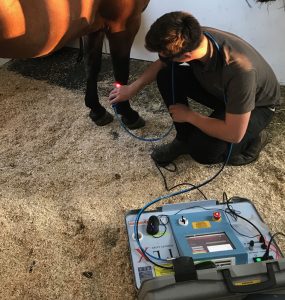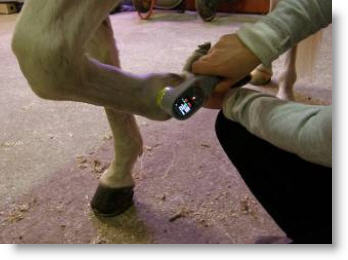Equine Therapy for Kid: Emotional and Behavior Support Described
Equine Therapy for Kid: Emotional and Behavior Support Described
Blog Article
Laser Treatment in Equine Therapy: A Modern Method to Improving Equine Health
Laser treatment has arised as a pivotal technique in equine treatment, making use of concentrated light energy to foster mobile repair and accelerate recovery from a variety of conditions. By boosting mitochondrial task and boosting ATP manufacturing, laser therapy not only enhances circulation yet likewise offers considerable pain alleviation.
Recognizing Laser Therapy
Laser treatment, a non-invasive therapy method, has gotten substantial grip in equine medicine due to its efficiency in advertising healing and pain alleviation. This advanced healing method uses concentrated light energy to pass through cells, cultivating mobile repair work and regrowth. The underlying device involves the excitement of cellular mitochondria, bring about boosted production of adenosine triphosphate (ATP), the power currency of cells. Boosted ATP levels accelerate cells repair processes and decrease swelling, making laser treatment particularly effective for treating bone and joint injuries, injuries, and various other inflammatory conditions in horses.
There are a number of kinds of lasers made use of in equine treatment, each with specific wavelengths and power results tailored to various therapeutic demands. Low-level laser treatment (LLLT), additionally called cold laser therapy, employs reduced power degrees to boost cell function without causing thermal damages. High-intensity laser therapy (HANDLE), in comparison, makes use of greater power degrees to attain deeper tissue penetration and even more substantial healing results.
Veterinarians make use of various laser devices and methods depending upon the problem being dealt with and the wanted depth of cells penetration. Correct training and expertise are vital for making certain the secure and effective application of laser therapy, thus optimizing its therapeutic potential while reducing threats.
Benefits for Horse Health
With a strong understanding of exactly how laser treatment functions, it is necessary to explore its numerous advantages for equine health and wellness. Among the primary benefits is its capability to speed up cells fixing and cell development. By boosting mobile feature, laser therapy promotes faster wound recovery and aids in the regeneration of broken tissues. This can be especially beneficial in minimizing recuperation times for equines experiencing injuries.
Furthermore, laser treatment has been revealed to boost flow, therefore improving blood circulation to influenced areas. Improved circulation guarantees that necessary nutrients and oxygen are delivered much more successfully, facilitating the healing process. Additionally, laser treatment's anti-inflammatory results assist in reducing swelling and discomfort, which is essential for the overall well-being of the horse.
Discomfort administration is another considerable advantage. By releasing endorphins and obstructing pain signals, laser therapy offers reliable, non-invasive remedy for both severe and persistent pain. This can add to enhanced movement and top quality of life for the animal.
Last but not least, laser treatment is a non-invasive therapy alternative, minimizing the Full Article threat of issues connected with even more intrusive treatments. Its adaptability and efficiency make it an indispensable tool in modern-day horse vet medication.
Typical Problems Dealt With

Another widespread condition treated with laser therapy is joint inflammation. In addition, laser treatment is used in the management of injuries.
Horse respiratory system conditions, such as persistent respiratory tract obstruction (RAO), likewise react positively to laser treatment. The anti-inflammatory buildings of the treatment help in reducing airway swelling, hence improving breathing function. Laser therapy is useful in treating hoof problems, consisting of laminitis and abscesses. By enhancing blood circulation and lowering pain, it supports quicker recovery.
Treatment and Safety And Security
Implementing laser treatment in equine therapy involves a careful procedure to guarantee both efficiency and safety. Equine Therapy. The procedure starts with a comprehensive vet assessment to establish the viability of laser treatment for the steed's particular condition. When deemed appropriate, the therapy area is prepared by cleaning and, if necessary, clipping the hair to improve laser infiltration
The practitioner has to pick the proper sort of laser, typically a low-level laser (LLLT) or a high-power laser (HPL), relying on the problem being dealt with. The laser tool is after that calibrated to the suitable wavelength, power, company website and period settings. During the application, the professional relocates the laser over the targeted location in an organized way, ensuring constant and even direct exposure.
Safety protocols are purely stuck to, consisting of making use of safety eyewear for both the expert and the steed. In addition, it is vital to monitor the equine for any signs of discomfort or unfavorable responses see page throughout the treatment. Post-treatment, the horse is frequently offered a period of rest to enable the healing impacts to show up.

Future of Horse Laser Treatment
As advancements in vet medicine remain to unravel, the future of equine laser treatment holds significant pledge. Emerging technologies and deeper clinical understandings are readied to refine and increase the applications of laser treatment for horses. Among one of the most expected developments is the assimilation of sophisticated imaging techniques that enable extra exact targeting of affected cells, consequently enhancing healing results. Additionally, the growth of portable and user-friendly laser gadgets is likely to make this therapy much more accessible to a more comprehensive variety of practitioners and steed owners.
In addition, recurring research right into the molecular and cellular systems of laser treatment will likely produce optimized methods tailored to details conditions, boosting efficiency and decreasing therapy times. Personalized therapy plans based on hereditary and biochemical markers can come true, ensuring that each equine obtains the most proper and effective treatment.
In addition, regulatory improvements and standardization of methods will improve the reliability and dependability of laser treatment in equine technique. Equine Therapy. As these innovations remain to arise, equine laser treatment is positioned to become a vital component of veterinary care, offering improved healing and enhanced quality of life for equines internationally
Verdict

Report this page